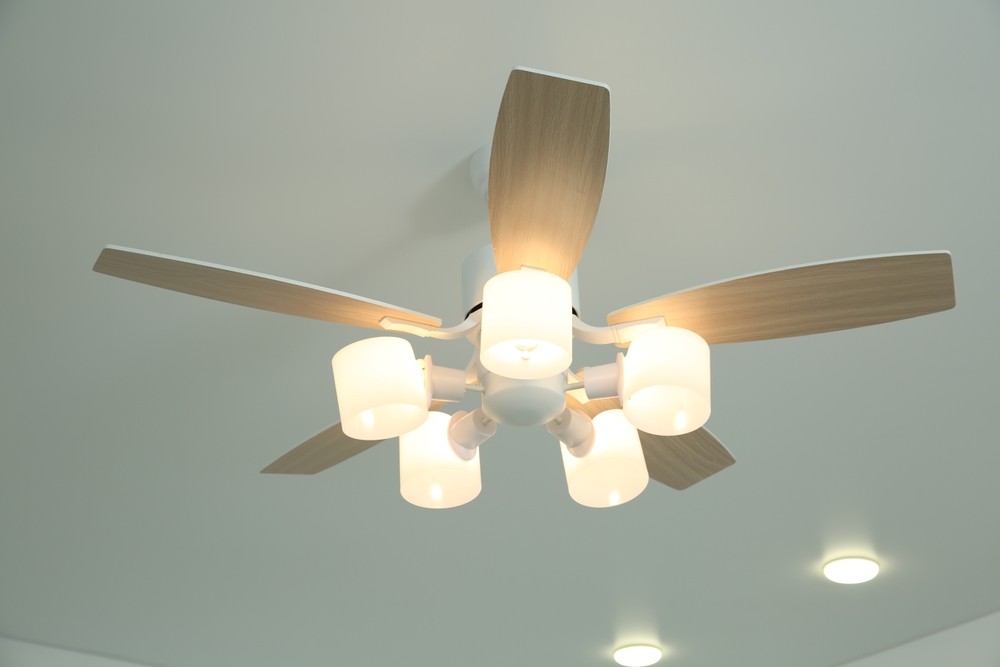One major area of focus for every homeowner should be how to reduce cooling expenses, especially given how utility bills can spike during warmer months. While air conditioners provide immediate relief from the heat, they are notorious for high energy consumption. Ceiling fans are a great alternative, offering a sustainable, cost-effective solution to enhance comfort without significantly increasing energy bills.
The Efficiency of Ceiling Fans
Ceiling fans are lauded for their ability to reduce the perceived temperature in a room without altering the actual air temperature. Operating on a simple yet effective principle, ceiling fans circulate air to create a wind chill effect. As air moves across the skin, it accelerates the evaporation of moisture, making the room feel cooler than it actually is. This allows homeowners to raise their thermostat setting by about four degrees Fahrenheit without sacrificing comfort.
The impact of this slight thermostat adjustment should not be underestimated. For every degree the thermostat is increased, homeowners could see a reduction in cooling costs by up to 10%. Consequently, ceiling fans can play a significant role in reducing energy usage, especially during peak summer months.
Cost-Effective Cooling
Installing ceiling fans is a relatively low-cost investment with a considerable return. The initial cost of a ceiling fan can vary depending on the style and features, but generally, they are more affordable than installing or upgrading an air conditioning system. Ceiling fans consume far less electricity than air conditioners. Even with continuous use, a ceiling fan might only use 30 to 50 watts of energy, whereas a central air conditioning unit can consume upwards of 3,500 watts.
Ceiling fans require minimal maintenance, which further reduces long-term costs. Routine cleaning and occasional balancing or tightening of screws will keep a fan running efficiently. Replacing a ceiling fan that is outdated or inefficient can also be more cost-effective than overhauling a central air system.
Versatility and Aesthetics
Ceiling fans are available in various designs, colors, and finishes, making them adaptable to any interior décor. Whether installed in the living room, bedroom, or outdoor patio, they enhance the aesthetic appeal while providing functional benefits. Many modern fans come equipped with additional features such as integrated lighting, remote controls, or smart home compatibility, further increasing their convenience and value.
One advantageous feature of many ceiling fans is the reversible motor. During warmer months, the fan blades should rotate counterclockwise, pushing air down to create the cool breeze felt in the room. Conversely, in the winter months, reversing the motor to spin the blades clockwise helps distribute warm air that collects near the ceiling down into the living space, allowing homeowners to maximize the efficiency of their heating systems. This dual functionality supports year-round energy savings.
Strategic Placement for Maximum Efficiency
Achieving optimal performance from ceiling fans depends significantly on their placement within a home. Proper placement ensures even air circulation, enhancing their cooling effect and energy-saving potential. Ceiling fans should ideally be installed in every primary living space, approximately seven to nine feet from the floor, for optimal air movement.
In larger rooms or open-concept areas, multiple fans may be necessary to ensure consistent airflow. The common misstep of selecting fans based solely on style is easily remedied by consulting the manufacturer’s guidelines on appropriate fan size relative to room dimensions. A fan that is too small for a room will struggle to circulate air efficiently, while an oversized fan may consume more energy than necessary without delivering proportionate cooling benefits.
Environmental Benefits
Incorporating ceiling fans into home cooling strategies contributes positively to environmental conservation. By lowering the reliance on air conditioning, which often runs on fossil-fuel-derived electricity, ceiling fans help reduce a household’s carbon footprint. Many fans are made from sustainable materials, contributing to eco-friendly home improvements.
Homeowners committed to reducing their environmental impact may also explore energy-efficient models certified by ENERGY STAR. These fans deliver exceptional performance with lower energy consumption rates, epitomizing the marriage of sustainability and style. With growing consumer interest in greener home solutions, the market now offers a diverse array of energy-smart ceiling fans that align aesthetics with functionality.
Maintenance and Upkeep
Preserving the efficiency of ceiling fans over time requires only modest upkeep. Regular cleaning of fan blades prevents dust and grime accumulation, which can hinder airflow and lead to motor strain. Balance issues, indicated by wobbling or unusual noise, are resolved by ensuring the fan is securely mounted and that each blade is even and undistorted. Some fans come with balancing kits for this purpose.
Lubrication, if needed, should be applied to the motor at intervals recommended by the manufacturer. Newer models may use sealed, maintenance-free motors that simplify long-term care. With these minimal maintenance steps, ceiling fans can remain effective for many years, providing sustained energy savings and comfort.
The Future of Ceiling Fans in Smart Homes
Ceiling fans are no longer the simple appliances they once were. Today’s smart ceiling fans integrate seamlessly with home automation systems, offering advanced features like voice control, automated scheduling, and integration with other smart devices. These fans can be programmed to operate in conjunction with other climate control systems, further boosting energy efficiency.
Ceiling fans that respond to room occupancy can turn on or off automatically, ensuring that energy is not wasted when a room is unoccupied. Features like variable speed settings allow users to adjust fan activity based on specific cooling needs, reducing energy usage further when full power isn’t necessary.
Incorporating ceiling fans into smart home systems not only enhances convenience but also plays a pivotal role in bolstering the home’s overall energy management strategy. As technology continues to evolve, so too will the features and capabilities of these fans, making them an indispensable part of modern, energy-efficient homes.
Energy-saving innovations like ceiling fans offer a straightforward path to reducing cooling expenses while also enhancing the aesthetic and livability of a home. Their ability to increase comfort, lower utility bills, and decrease environmental impact makes ceiling fans an excellent investment. In the pursuit of sustainable living, ceiling fans represent a practical, attractive, and essential solution for every household.



